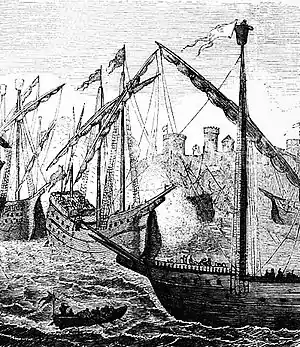Dano-Hanseatic War (1426–1435)
The Dano-Hanseatic War from 1426–1435 (as was the Kalmar War with the Hanseatic League) was an armed trade conflict between the Danish-dominated Kalmar Union (Denmark, Norway, Sweden) and the German Hanseatic League (Hansa) led by the Free City of Lübeck.[1]
| Dano-Hanseatic War (1426–1435) | |||||||||
|---|---|---|---|---|---|---|---|---|---|
| Part of Eric of Pommerania's Schleswig wars | |||||||||
 Hanseatic ships infront of Copenhagen, Denmark, 1428 | |||||||||
| |||||||||
| Belligerents | |||||||||
|
Co-belligerent: |
Supported by: | ||||||||
| Commanders and leaders | |||||||||
|
|
| ||||||||
| Strength | |||||||||
|
|
| ||||||||
When Danish king Eric opened the Baltic trade routes for Dutch ships and introduced a new toll for all foreign ships passing the Øresund (Sound Dues), six Hanseatic cities (Hamburg, Lübeck, Lüneburg, Rostock, Stralsund, Wismar) declared war, put a naval blockade on Scandinavian harbours and allied with Eric's enemy Henry IV, count of Holstein. Therefore the war was intensively linked with the Dutch–Hanseatic War (1422/38–1441), the Kalmar War with Holstein (1409/22–1435) and the Swedish revolt (1434–1436).
After years of changing fortune in warfare Rostock and Stralsund signed a separate peace agreement in 1430. Lübeck, Hamburg, Wismar and Lüneburg, however, continued the war and assisted Holstein to conquer Flensburg in 1431. Thereafter they agreed an armistice in 1432 and started peace negotiations. Meanwhile an anti-Danish revolt broke out in Sweden (Engelbrekt rebellion). In 1434 Eric had to agree an armistice with the Swedes, too. In April 1435 he signed the peace of Vordingborg with the Hanseatic League and Holstein, followed by the peace of Stockholm with Sweden a few months later the same year. The Hanseatic cities were excepted from the Sound Dues but they had to accept Dutch competition in the Baltic trade. The Danish Duchy of Schleswig was ceded to the count of Holstein. Sweden's autonomous rights and privileges were extended. These peace agreements weakened Eric's position dramatically, and in 1439 he got dethroned by Danish, Swedish and Norwegian Privy Councils.
Timeline
- 1426 – Danish troops reconquer Flensburg (Sleswig) which was occupied by Holstein before
- 1427 – Hanseatic plunder of Bornholm
- 1427 – failed Holstein-Hanseatic attack against Flensburg
- 1427 – Danish and Swedish naval forces defeat a Hanseatic fleet in the Øresund
- 1428 – two Hanseatic attacks against the joint Danish-Swedish fleet in Copenhagen
- 1428 and 1429 – Bergen (Norway) plundered by those Victual Brothers who allied with Holstein and Hansa
- 1429 – failed Danish-Swedish naval operation against Stralsund
- 1429 – Hanseatic capture of a Swedish transport fleet
- 1430 – peace between Denmark, Rostock and Stralsund
- 1431 – Holstein-Hanseatic troops conquer Flensburg
- 1432 – armistice between Denmark and the Hanseatic League
- 1434 – begin of the Swedish revolt, armistice between Denmark and Sweden
- 1435 – peace of Vordingborg, peace of Stockholm
 Barnim VIII of Pomerania defeated the Hansa fleet (1427)
Barnim VIII of Pomerania defeated the Hansa fleet (1427) Queen Philippa led the defence of Copenhagen (1428)
Queen Philippa led the defence of Copenhagen (1428) King Eric was dethroned after the unlucky war (1439)
King Eric was dethroned after the unlucky war (1439)
References
- Bellingradt, Daniel; Reynolds, Anna (2021-04-12). The Paper Trade in Early Modern Europe: Practices, Materials, Networks. BRILL. p. 187. ISBN 978-90-04-42400-5.
Sources
External links
- European-heritage.org: The Chronicle of the Hanseatic League
- Encyclopædia Britannica online: The Kalmar Union